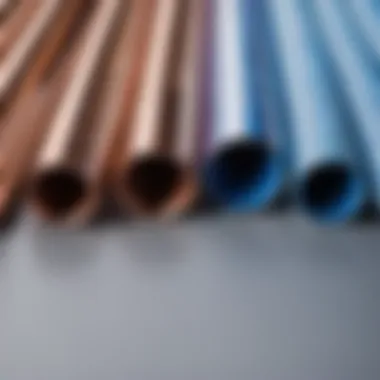A Comprehensive Comparison of Copper vs. PEX Repiping: Unveiling the Best Choice for Your Plumbing Needs


Materials:
List of Materials:
- Copper pipes (1/2 inch diameter) x100 ft
- PEX pipes (1/2 inch diameter) x100 ft
- Pipe cutter
- Crimping tool
- Pipe insulation
- Pipe supports
- Shutoff valves
- Connectors
- SharkBite fittings
DIY Steps:
Detailed Instructions:
- Measure and mark the areas where repiping is needed.
- Turn off the main water supply to the house.
- Use a pipe cutter to remove the old pipes.
- Install pipe supports every 4 feet along the new pipe installation path.
- Install shutoff valves at necessary junctions.
- Connect the new pipes using appropriate connectors or SharkBite fittings.
- Insulate pipes in exposed or cold areas.
Technical Aspects:
List of Tools:
- Pipe cutter
- Crimping tool
- Measuring tape
- Marker Timing Specifics:
- Allow 1-2 days for completing the repiping project. Critical Techniques:
- Ensure proper alignment and secure connections for leak-free plumbing system.
DIY project Process:


Sequential Steps:
- Start by planning the repiping layout and marking the pipe paths.
- Cut the copper or PEX pipes to required lengths using a pipe cutter.
- Use the crimping tool to secure connections in PEX piping or solder joints in copper piping.
- Install pipe supports at regular intervals and insulate where needed.
- Attach shutoff valves and connections as per the layout design.
- Test the newly installed piping system for leaks by turning on the water supply.
Troubleshooting Tips:


Common Mistakes:
- Incorrect measurement leading to wastage of materials.
- Inadequate support resulting in sagging pipes. Adjustments:
- Double-check measurements before cutting pipes.
- Revisit pipe supports to ensure stability of the plumbing system.
Introduction


In the realm of plumbing, the decision between repiping with copper versus PEX materials is a crucial one, with far-reaching implications for the integrity and functioning of a household's plumbing system. This article serves as a beacon of knowledge, shedding light on the intricacies of this pivotal choice and aiming to equip housewives and homeowners with the necessary insights to navigate this decision-making process confidently.
The significance of this comparison cannot be overstated, as a plumbing system forms the backbone of any home, ensuring the seamless flow of water for everyday needs. By delving into the core characteristics of copper and PEX piping, we unearth a plethora of factors that impact the durability, cost-effectiveness, installation complexity, and environmental footprint of each material. Through a meticulous analysis of these aspects, readers will gain a comprehensive understanding of how these two options stack up against each other, allowing them to make well-informed choices tailored to their specific plumbing requirements.
This article goes beyond mere surface-level comparisons, aiming to provide a holistic view of the implications associated with repiping decisions, delving deep into the intricacies of installation processes, costs involved, and the broader environmental ramifications. By exploring the nuances of each material in detail, readers will be empowered to make decisions that not only meet their immediate plumbing needs but also align with their long-term sustainability goals. So, join us on this journey of exploration as we unravel the layers of copper and PEX piping, illuminating the path towards a more informed and judicious approach to repiping choices.
Characteristics of Copper Piping
In this article delving into a detailed comparison of repiping with copper and PEX materials, examining durability, cost-effectiveness, installation complexity, and environmental impact, the characteristics of copper piping play a crucial role. Copper piping has been a staple in plumbing systems for years due to its remarkable properties and benefits, making it a preferred choice for many homeowners and plumbers alike.
Durability
Longevity
When discussing the longevity of copper piping, it is important to note that this material is known for its exceptional lifespan. Copper pipes can endure for decades, often outlasting other piping materials due to their inherent strength and resistance to wear and tear. The longevity of copper piping contributes significantly to the reliability of plumbing systems, offering peace of mind to homeowners knowing that their pipes are built to last.
Resistance to Corrosion
Another key aspect of copper piping is its resistance to corrosion. Copper is naturally corrosion-resistant, making it ideal for plumbing applications where exposure to water is constant. This resistance ensures that copper pipes maintain their integrity over time, minimizing the risk of leaks and damage. The unique feature of corrosion resistance in copper piping not only enhances its durability but also reduces the need for frequent repairs, translating to long-term cost savings.
Flexibility
Suitability for Various Installations
Copper piping's flexibility is showcased in its suitability for various types of installations. Whether it's a simple residential plumbing system or a complex industrial setup, copper pipes can adapt to different environments seamlessly. The flexibility of copper piping makes it a versatile choice for plumbers, allowing for creative and efficient plumbing designs that cater to specific needs. The unique feature of copper piping's flexibility enables easy customization and precise installations, ensuring optimal performance in any setting.
Cost Considerations
Material Costs
The material costs associated with copper piping reflect its quality and longevity. While copper pipes may have a higher upfront cost compared to other materials, such as PEX, their durability and lifespan justify the investment. Copper piping's superior quality and longevity make it a cost-effective choice in the long run, minimizing the need for frequent replacements or repairs.
Labor Costs
In terms of labor costs, copper piping may require skilled labor for installation due to its unique soldering techniques and fittings. Although labor costs for copper piping installations may be higher initially, the expertise required ensures precise and durable plumbing systems. The upfront investment in labor for copper piping installations pays off in the form of reliable and long-lasting plumbing infrastructures, reducing the likelihood of maintenance issues in the future.
Characteristics of PEX Piping
In this article, exploring the Characteristics of PEX Piping is crucial to providing a detailed analysis of repiping options with copper vs. PEX materials. PEX piping offers a range of unique features and considerations that set it apart in the plumbing industry.
Flexibility
Ease of Installation
The Ease of Installation aspect of PEX piping is a standout feature that significantly impacts repiping projects. Its ability to be easily maneuvered and fitted into various spaces makes it a preferred choice for many plumbing professionals. Unlike rigid copper piping, PEX can be bent and shaped without the need for complex fittings, reducing installation time and labor costs.
Ability to Curve around Obstacles
The Ability to Curve around Obstacles further enhances the versatility of PEX piping. This unique feature allows PEX pipes to navigate through tight spaces and around corners with ease, ensuring a seamless and efficient installation process. This flexibility eliminates the need for additional fittings or joints, reducing the risk of leaks and potential repairs in the future.
Durability
Resistance to Scale Build-up
One of the key benefits of PEX piping is its Resistance to Scale Build-up, which helps maintain consistent water flow and pressure over time. Unlike traditional metal pipes that are prone to scaling and corrosion, PEX piping resists such build-ups, ensuring long-term durability and performance. This characteristic prolongs the lifespan of the piping system and minimizes the need for maintenance.
Potential for Leaks
While PEX piping boasts exceptional durability, its Potential for Leaks is a consideration for homeowners and plumbers. Although PEX pipes are highly resistant to leaks due to fewer joints and connections, improper installation or damage can lead to potential leakage issues. Regular inspections and proper installation techniques are essential in mitigating any risks associated with leaks.
Cost Considerations
Material Costs
When it comes to Material Costs, PEX piping offers a cost-effective solution compared to traditional copper piping. The raw materials used in manufacturing PEX are less expensive, making it a budget-friendly option for repiping projects. Furthermore, the lightweight nature of PEX reduces transportation and handling costs, adding to its overall affordability.
Repair and Maintenance Costs
In terms of Repair and Maintenance Costs, PEX piping typically incurs lower expenses compared to copper piping. The flexibility and durability of PEX pipes often result in fewer repairs and maintenance requirements over time. However, it is crucial to consider the quality of installation and potential risks of leaks that may impact long-term maintenance costs.
Comparison of Installation Process
The comparison of installation processes between copper piping and PEX piping plays a crucial role in this article as it delves into the practical aspect of repiping projects. This section aims to provide a detailed analysis of the methods involved in installing both types of piping, shedding light on the unique characteristics, benefits, and considerations to help readers make informed decisions regarding their plumbing systems. By examining the distinct approaches required for copper and PEX piping installations, individuals can better understand the intricate nature of repiping projects.
Copper Piping
Soldering Techniques
When it comes to copper piping, soldering techniques stand out as a fundamental aspect of the installation process. Soldering involves joining copper pipes using a heated solder material to create secure and durable connections. The key characteristic of soldering techniques lies in their ability to create watertight seals, ensuring leak-free plumbing systems. This method is a popular choice for its reliability and longevity, making it a preferred option in the construction and plumbing industries. However, soldering requires skill and precision, and improper application can result in leaks or weak joints, necessitating careful attention during the installation process.
Complexity of Fittings
The complexity of fittings in copper piping installations adds another layer of consideration for plumbing projects. Copper piping systems often require a variety of fittings, including elbows, tees, and couplings, to navigate around corners and obstacles in a plumbing layout. The key characteristic of these fittings lies in their durability and resistance to high temperatures and pressure, ensuring the integrity of the overall plumbing network. While copper fittings offer reliability and robustness, the intricate nature of some fittings can increase the complexity of installations, requiring skilled labor and meticulous planning to ensure a seamless repiping process.
PEX Piping
Use of Crimping Tools
In the realm of PEX piping, the use of crimping tools plays a pivotal role in the installation process. Crimping tools are utilized to secure PEX pipes to fittings by compressing metal rings over the joints, creating strong and permanent connections. The key characteristic of crimping tools is their simplicity and efficiency, allowing for quick and straightforward installations without the need for complex soldering or gluing processes. This method is favored for its ease of use and versatility, making it a popular choice for homeowners and contractors alike. However, proper calibration and technique are essential to ensure a tight and reliable connection, highlighting the importance of meticulous attention to detail when employing crimping tools in PEX piping installations.
Expansion Fittings
Another crucial aspect of PEX piping installations is the use of expansion fittings, which rely on an expanding tool to enlarge the PEX pipe for fitting insertion. Expansion fittings offer a unique approach to connecting PEX pipes without the need for traditional welding or soldering methods. The key characteristic of expansion fittings is their ability to create strong and flexible joints that can withstand varying temperatures and pressures, ideal for versatile plumbing applications. While expansion fittings provide convenience and adaptability, the initial investment in the expansion tool and fittings can be higher compared to other methods, necessitating a cost-benefit analysis for each repiping project. Understanding the intricacies of expansion fittings is essential for optimizing the installation process and ensuring a reliable plumbing system in PEX piping projects.
Environmental Impact
In this detailed comparison between copper and PEX repiping materials, the environmental impact plays a vital role in decision-making. Understanding the implications of each material choice is crucial for individuals looking to make environmentally conscious decisions. Environmental impact encompasses various elements that extend beyond the immediate installation process and into the long-term sustainability of the chosen material.
Copper
Resource Extraction
Resource extraction is a fundamental aspect to consider when examining the environmental impact of copper piping. The process of extracting copper involves mining operations, leading to significant energy consumption and potential environmental disturbances. However, copper is a widely available material that can be recycled efficiently, reducing the need for extensive mining activities and thereby minimizing its overall environmental footprint.
Recyclability
Highlighting another essential aspect of copper's environmental impact, recyclability showcases the sustainable nature of this material. Copper holds a high recyclability rate, making it a valuable choice for individuals seeking eco-friendly repiping solutions. The ability to recycle copper piping reduces waste generation and promotes a circular economy approach to material usage.
PEX
Manufacturing Process
The manufacturing process of PEX piping is a critical consideration when evaluating its environmental impact. Unlike copper, PEX is a synthetic material that undergoes specific manufacturing procedures. These processes may involve the use of chemicals and energy-intensive practices, which can contribute to environmental consequences. However, advancements in technology have allowed for more sustainable production methods, ensuring that PEX can be manufactured with reduced ecological impacts.
Disposal Concerns
Disposal concerns associated with PEX piping revolve around the material's end-of-life stage. Proper disposal and recycling of PEX can pose challenges due to its composition and recycling limitations. While PEX is designed for longevity, its disposal requires careful consideration to minimize environmental harm. Implementing proper disposal protocols and exploring innovative recycling solutions are essential to mitigate the environmental effects of PEX piping.
Conclusion
In this meticulous comparison of repiping with copper versus PEX, the conclusion serves as a crucial element in guiding readers towards making informed decisions regarding their plumbing systems. By summarizing and synthesizing the key aspects presented throughout the article, the conclusion encapsulates the benefits, considerations, and nuances associated with choosing between copper and PEX materials for repiping projects.
At its essence, the conclusion acts as a compass for readers, directing them towards the most suitable option based on their specific needs and preferences. Whether prioritizing durability, cost-effectiveness, ease of installation, or environmental impact, the conclusion ties together these diverse factors to offer a holistic perspective on the two repiping choices.
Moreover, the conclusion underscores the significance of considering long-term implications when selecting between copper and PEX piping. By delving into aspects like maintenance requirements, potential leakages, and overall lifespan, readers are equipped to anticipate the practical implications of their decision and ensure a sustainable plumbing solution for their household.
Furthermore, the conclusion emphasizes the need for a personalized approach to repiping decisions, recognizing that individual circumstances, budget constraints, and sustainability concerns vary among homeowners. By encouraging readers to weigh the trade-offs between copper and PEX based on their unique situation, the conclusion empowers them to make confident and well-informed choices that align with their overarching goals.
Ultimately, the conclusion acts as a reaffirmation of the article's central purpose – to offer a comprehensive and detailed comparison of repiping with copper versus PEX materials, enabling readers to navigate the complexities of plumbing upgrades with clarity and precision.



